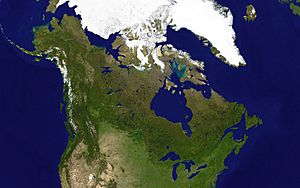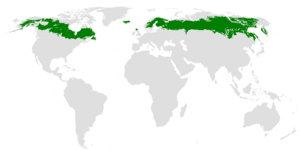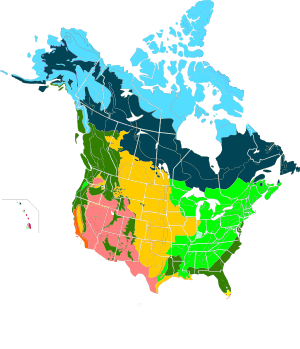Boreal forest of Canada facts for kids
Canada's boreal forest is a massive green belt of trees. It makes up about one-third of the entire boreal forest that circles the northern hemisphere. This huge forest mostly sits north of the 50th parallel, which is an imaginary line around the Earth.
Contents
Canada's Amazing Boreal Forest
The boreal forest is one of the world's largest forests. It is like a giant green crown around the top of the Earth. Canada's part of this forest is incredibly important. It covers a huge area, stretching from one side of the country to the other. This forest is a vital part of our planet's health.
What is the Boreal Forest?
The term "boreal" means "of the north." So, a boreal forest is a northern forest. These forests are found in cold regions. They have long, cold winters and short, cool summers. The trees here are mostly evergreens, like spruce, fir, and pine. They keep their needles all year round. This helps them survive the harsh winter weather.
Where is This Huge Forest?
Canada's boreal forest covers a massive area. It stretches across nearly 60% of Canada's landmass. This includes parts of almost every province and territory. From Yukon and the Northwest Territories in the west, all the way to Newfoundland and Labrador in the east. It's a truly enormous natural space. This forest is part of a larger global forest system. This system circles the entire northern part of the world. Other countries with boreal forests include Russia, Sweden, Finland, and Norway.
Plants and Trees of the Boreal
The boreal forest is home to many different kinds of plants. The most common plants are the trees. But there are also many smaller plants, mosses, and lichens. These plants have adapted to the cold climate. They can handle the long, snowy winters.
Mighty Trees of the North
The main trees in the boreal forest are conifers. These are trees that produce cones and have needles instead of leaves. Common types include black spruce, white spruce, balsam fir, and jack pine. You might also find some deciduous trees. These trees lose their leaves in the fall. Examples are trembling aspen, balsam poplar, and white birch. These trees grow tall and strong. They form a dense canopy that shades the forest floor.
Smaller Plants and Flowers
Beneath the tall trees, many smaller plants thrive. The forest floor is often covered in thick mosses and lichens. These plants can grow in damp, shady conditions. You might also find shrubs like Labrador tea and blueberry bushes. In the spring and summer, colorful wildflowers bloom. One beautiful example is the Calypso orchid. Another common flower is fireweed, which often grows after forest fires. These plants provide food and shelter for many animals.
Animals Living in the Boreal
The boreal forest is a busy place for wildlife. Many animals call this forest their home. They have special ways to survive the cold winters. Some animals hibernate, while others have thick fur or feathers.
Mammals of the Forest
Many large mammals live in the boreal forest. You might spot a moose munching on plants. Caribou herds roam through the trees. Black bears and grizzly bears search for food. Predators like wolves and lynx hunt smaller animals. Smaller mammals include beavers, snowshoe hares, and red squirrels. These animals are all part of the forest's food web.
Birds and Other Creatures
The boreal forest is a very important place for birds. Millions of birds come here to nest and raise their young. Many types of warblers, like the Canada warbler, nest on the ground. Owls, eagles, and hawks also live here. Waterfowl, like ducks and geese, use the many lakes and wetlands. Besides birds, you can find many insects. These include mosquitoes, which are a food source for birds. There are also amphibians and reptiles, though fewer than in warmer climates.
Why is the Boreal Forest Important?
The boreal forest is much more than just a collection of trees. It plays a huge role in keeping our planet healthy. It helps us in many ways, from providing homes for animals to cleaning our air.
A Home for Wildlife
As we've seen, the boreal forest is a critical habitat. It provides food, shelter, and breeding grounds for countless species. Many animals depend entirely on this forest to survive. Protecting the forest means protecting these animals. It helps keep the natural balance of our ecosystems.
Cleaning Our Air
Trees are like giant air filters. They absorb carbon dioxide, a gas that contributes to climate change. They then release oxygen, which we need to breathe. The boreal forest stores a massive amount of carbon. It helps to regulate the Earth's climate. This makes it a very important tool in fighting global warming.
Water and Climate Control
The boreal forest also plays a big role in managing water. Its vast network of wetlands, lakes, and rivers helps filter water. It also helps prevent floods. The forest influences weather patterns. It contributes to rainfall and helps keep temperatures stable. It's like a natural air conditioner for the planet.
Protecting the Boreal Forest
Even though the boreal forest is huge, it faces challenges. It's important to understand these challenges. We need to work together to protect this amazing natural treasure for the future.
Challenges the Forest Faces
One challenge is logging. Trees are cut down for wood products. While some logging is sustainable, too much can harm the forest. Mining and oil and gas development also impact the forest. They can clear land and pollute water. Wildfires are a natural part of the forest cycle. But climate change can make them more frequent and intense. This can cause more damage than usual.
How We Can Help
There are many ways to help protect the boreal forest. Supporting sustainable forestry practices is one way. This means using wood products that come from forests managed responsibly. Reducing our carbon footprint helps fight climate change. This can lessen the risk of extreme wildfires. Learning about the forest and sharing its importance with others is also key. Every little bit helps to keep this vital ecosystem healthy.
Images for kids
-
The Calypso orchid grows in the shade of boreal forests.
-
A Sphagnum bog with spruce trees on a forested ridge in Quebec
-
Sheep laurel grows in clearings and shallow soils. It can form extensive shrub barrens after logging.
-
The Canada warbler nests on the ground in boreal forests.











